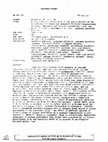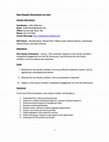Papers by Kelly Wilkinson

These six papers present sound research in business education. "Status of Full-and Part-Time Busi... more These six papers present sound research in business education. "Status of Full-and Part-Time Business Faculty at Two-Year College and Perceived Importance of Selected Professional Services" (Marcia A. Anderson, Sharon Resch) reports full-time faculty received more professional services, and part-time faculty valued professional services differently. "Engineering Professionals: Their Need for Computer Keyboarding. Competency" (Deborah K. Ryker, Marcia Anderson) finds over three-fourths of university engineering graduates indicated computer keyboarding skills were not a prerequisite for their work position; most found computer keyboarding skills improved their work productivity substantially or some; and the majority felt these skills should be required. "Early Field Experience: One Approach to Contextual Teaching and Learning" (Wanda L. Stitt-Gohdes) reports research that supports inclusion of extensive early field experiences in business education preservice programs because they provide a context where students observe the extent to which current teachers make a connection between school-and work-based learning. "Issues of Multicultural Education: Attitudes of Business and Marketing Education Teachers" (Elaine Adams, Helen C. Hall) indicates teachers tended to reflect positive attitudes about the multicultural issues raised. "Advising Challenging in Cyberspace" (Barbara

Journal of Organizational Culture Communications and Conflict, Jul 1, 2004
ABSTRACT This document studies and determines if students are being provided with skills necessar... more ABSTRACT This document studies and determines if students are being provided with skills necessary to succeed in business and teamwork, collaborative writing, and group projects. The study was performed at a state supported Mid-Atlantic University using eight sections of Business and Interpersonal Communication. In the following sections, we explore the various aspects of business and teamwork, collaborative writing, and group projects. First, we discuss the purpose of the study, introducing the three research questions necessary to provide the focus for the study. Next, we present the literature review, which contains information regarding collaborative writing, cooperative learning, meetings, caveats about small groups, and simulation. Further, we discuss the methodology, including the target population and the project description. Then the reactions and implications include student responses from each business communication section. We conclude the document with recommendations which include information necessary to replicate the project. INTRODUCTION In today's Total Quality Management atmosphere, the use of small groups and collaborative writing projects appears to be significant. Competent communicators have learned to work effectively in small groups to gather and analyze data and then to write and revise a written report or to prepare an oral presentation. Regardless of the size of the organization, members must periodically divide into small groups to accomplish some objective. In fact, small groups might range from one-time, on-the-spot meetings to permanent committees; and in a business career, students as future employees, are likely to participate in collaborative writing projects. That is, they will work on a report with others. Group involvement in report preparations is becoming increasingly significant for a number of reasons. For one, the specialized knowledge of different people can improve the quality of the work. For another, the combined talents of the members are likely to produce a document better than could be done by any one of the members. Furthermore, dividing the work reduces the time needed for the project (Lesikar, Pettit, & Flatley, 2002). Given organizational trends of the prevalence of teamwork, collaborative writing, and group projects, astute business communication instructors will want (and need) to provide these learning experiences for business communication students. This paper presents a group project for business communication classes that incorporates active learning, collaborative writing, teamwork, cooperative learning, and the group process. RESEARCH QUESTIONS The purpose of the study is to examine the business communication course and to determine if students are being provided with skills necessary to succeed in business and teamwork, collaborative writing, and group projects. The first step in the research process involved a review of literature to determine what types of group activities instructors could or should be utilizing in the classroom. The second step involved the development of a group project focusing on planning meetings. The third step was to assign the project to students enrolled in the Business and Interpersonal Communication course to determine their perceptions of the effectiveness of such a project. Following a review of the literature, the following questions guided the study: 1. Are instructors who teach business communication courses providing students with skills necessary to succeed in business and teamwork, collaborative writing, and group projects? 2. Does a meeting planning project in a business communication course teach students needed skill for success in business? 3. What are students' perceptions of effectiveness of a group project focusing on planning a meeting? LITERATURE REVIEW Collaborative Communications According to Ober (2003), the increasing quantity and complexity of the information available makes it difficult for any one person to have either the time or the expertise to analyze all data adequately. …

Accounting and Finance Research, 2015
Increasingly, people are asked to make investment decisions that affect their retirement. In the ... more Increasingly, people are asked to make investment decisions that affect their retirement. In the past, "experts" in the federal government, pension plans, and/or other money management entities made these decisions. The "expert" investor's skill set includes the ability to read and understand financial material. While there are many sources of financial information newspapers, mutual fund reports, annual reports and others, the purpose of this study is to determine the reading level of footnotes in financial statements. FASB has issued a Discussion Paper concerning footnote effectiveness (FASB, 2012) supporting the importance of the clarity of the footnotes. 100 firms' footnotes were analyzed using Word (from Office 2003 suite) spelling and grammar check. The average Flesch Index reading level of the footnotes was 20.4.This score indicates it is very difficult to read the footnotes. In fact based on the average reading level of adults, a large portion of the U.S. population are unable to understand footnotes.
Proceedings of the 36th annual ACM SIGUCCS fall conference: moving mountains, blazing trails, 2008
... Faculty Orientation Program Kenneth Janz Winona State University Somsen Hall, 111 Winona, MN ... more ... Faculty Orientation Program Kenneth Janz Winona State University Somsen Hall, 111 Winona, MN 55987 1-507-457-2299 kjanz@winona.edu Kelly Wilkinson Indiana State University College of Business, 714 Terre Haute, IN 47809 1-812-237-2077 kwilkinson2@indstate.edu ...

Providing effective assessment with appropriate feedback to e-learners has traditionally been a c... more Providing effective assessment with appropriate feedback to e-learners has traditionally been a challenge, particularly if the assessment process is designed to augment and reinforce learning. For rich feedback and meaningful assessment to occur, information must be presented in an engaging manner to serve both formative and summative pedagogical needs of the course. The feedback and assess- ment that e-instructors automate and provide to students in an asynchronous/synchronous e-environment is essential and critical to create value-added learning. While the use of video and audio assessment coupled with traditional written feedback approach work well in the traditional classroom environment, they are particularly well suited to e-learning students. Engaging students and providing appropriate, rich feedback and meaningful assessment are key factors in enhancing students' online experiences and success. As time on task and student engagement with the content are critical pedagog...
ED435844 - Connecting Education with Careers. Business Education Association for Career and Techn... more ED435844 - Connecting Education with Careers. Business Education Association for Career and Technical Education Annual Convention Proceedings (Orlando, Florida, December 11-15, 1999).
ED452393 - A Career Odyssey. Proceedings of the Annual Meeting of the Association for Career and ... more ED452393 - A Career Odyssey. Proceedings of the Annual Meeting of the Association for Career and Technical Education/International Vocational Education and Training Association (74th, San Diego, California, December 7-10, 2000). Business Education Division.
Delta Pi Epsilon Journal, 2006
Abstract: Students believe that they are computer literate. When asked, students perceive themsel... more Abstract: Students believe that they are computer literate. When asked, students perceive themselves as skilled in a variety of computer applications. This research compares students' perceptions with their reality. Students did not perform well on pretests of ...
Delta Pi Epsilon Journal, 1998
EJ596626 - Internet Homework Activities and Traditional Homework Activities: The Effects on Achie... more EJ596626 - Internet Homework Activities and Traditional Homework Activities: The Effects on Achievement, Completion Time, and Perception. ...

New Faculty Orientation-3 hours. This orientation supports a new faculty member's integration/eng... more New Faculty Orientation-3 hours. This orientation supports a new faculty member's integration/engagement into the ISU Community, and enhances the new faculty member's role as a teacher and researcher. Goals I. Enhance the new faculty member's role as an effective classroom teacher, and as appropriate a developmental advisor. II. Enhance the new faculty member's role as a productive researcher III. Support a new faculty member's integration/engagement into the ISU Community. Outcomes At the end of this orientation a new faculty member will be able to: 1. Understand ISU's culture and bureaucracy 2. Implement multiple teaching strategies for a student-centered classroom 3. Practice enhanced classroom management skills 4. Develop a teaching philosophy 5. Develop and/or maintain a research agenda as appropriate 6. Create a promotion and tenure portfolio 7. Create assessment instruments for courses 8. Utilize technology in classroom and research when appropriate 9. Understand the ISU student and climate

Increasingly, people are asked to make investment decisions that affect their retirement. In the ... more Increasingly, people are asked to make investment decisions that affect their retirement. In the past, “experts” in the federal government, pension plans, and/or other money management entities made these decisions. The “expert” investor’s skill set includes the ability to read and understand financial material. Wilkinson and Czyzewski (2013) found that the footnotes of the financial statements were written at a very high post graduate level. This paper will examine another piece of financial information investors use to help make investment decision. The purpose of the study is to determine the reading level of Management Discussion and Analysis Section of the 10-K. 100 firms’ Management Discussion and Analysis Section(MDA) of the 10-K were analyzed using Word (from Office 2003 Suite) Spelling and Grammar check. The average Flesch Index reading level of the MDA was 13.052. This score indicates it is very difficult to read the MDA. In fact based on the average reading level of adult...

IntroductionIn an online teaching and learning environment, quality course design impacts the qua... more IntroductionIn an online teaching and learning environment, quality course design impacts the quality of teaching. Much research has been completed on the Quality Matters (QM) Program, which is an international organization working to improve the design of online and blended courses. QM rubrics have been created to assist in the design of quality online courses. Research has also been conducted on Chickering and Gamson's (1987) seven principles for good practice in undergraduate education (Chickering & Gamson, 1999). Combining research on both quality design and quality teaching in the online environment is essential to assist faculty in helping students achieve set learning outcomes.Chickering and Gamson (1987) reviewed the literature to investigate good principles of teaching. The following resulted from their research as the seven principles for good practice in undergraduate education. Good teaching practice does the following:1. encourages contact between students and facul...

INTRODUCTIONFor many students, learning statistics is a challenge, so it is not surprising that t... more INTRODUCTIONFor many students, learning statistics is a challenge, so it is not surprising that those teaching statistics are continually looking for new and better ways to teach statistical concepts to students. The statistics education "reform" movement was acknowledged as early as 1995 (Rossman & Short, 1995). Within this movement, educators have been promoting the re-conceptualization of statistics courses to emphasize statistical reasoning, studentcentered learning, and the use of technology to allow students to analyze and interact with real data sets (Cobb, 1993; Garfield, 1995; Garfield, Hogg, Schau & Whittinghill, 2002). In 2005, the American Statistical Association's GAISE (Guidelines for Assessment and Instruction in Statistics Education) College Report formalized these ideas, making six recommendations for statistics instruction, including utilizing "technology for developing conceptual understanding and analyzing data" (GAISE, 2005). Recent studi...
Advancing Technology and Educational Development through Blended Learning in Emerging Economies
Many educational experts predict that in the future blended learning will become far more common ... more Many educational experts predict that in the future blended learning will become far more common than traditional Face-to-Face (F2F) or online learning. With this in mind, instructors are being asked or required to move F2F courses to a blended environment. When doing so, there are a variety of issues to consider. Thus, a framework for transference is necessary. This framework includes the seven principles for good practice for undergraduate education. This chapter covers the essential topics to help educators conduct a successful transference and uphold the quality of their courses.
TechTrends, 2014
Word clouds (or tag clouds) are popular, fun ways to display text data in graphical form; however... more Word clouds (or tag clouds) are popular, fun ways to display text data in graphical form; however, we contend that they can also be useful tools in assessment. Using word clouds, instructors can quickly and easily produce graphical depictions of text representing student knowledge. By investigating the patterns of words or phrases, or lack thereof, in textual student responses, instructors can evaluate if students, as a whole, have grasped or missed key concepts or have made common mistakes. Word clouds can be used to provide formative assessment feedback to students, and to identify common themes in student reflection papers. They can also be useful as a starting point or screening tool for large amounts of text data, whether related to assessment or not.
osra.org
Online learning is prevalent in today's universities. Advances in technology have led to cou... more Online learning is prevalent in today's universities. Advances in technology have led to courses being taught from behind computers rather than in front of students. With this method of teaching and learning, students and teachers face challenges and are ...
Business Communication Quarterly, 2010
Undergraduate business communication students were surveyed to determine their perceived most eff... more Undergraduate business communication students were surveyed to determine their perceived most effective method of assessment on writing assignments. The results indicated students’ preference for a process that incorporates visual, auditory, and e-handwritten presentation via a tablet PC. Students also identified this assessment process would improve their writing by helping them understand the types of errors they were making and why these errors were incorrect. Students also indicated this type of assessment would help build a relationship with the instructor and help them be successful in the class.

INTRODUCTION Drafting a resume is a difficult task. What should I include? How long should it be?... more INTRODUCTION Drafting a resume is a difficult task. What should I include? How long should it be? What kind of design should I use? These are the types of questions instructors, career services personnel, and recruiters are required to respond. Web sites have sprung up across the Internet offering advice on the development of personal resumes. In addition, Fortune 500 companies have been surveyed concerning resume content and design, and these findings have been published in journals or presented at conferences geared toward college educators and private sector trainers. A plethora of books have been published in the area of resume content and design with tips ranging from the elementary (be sure to type your resume) to the inane (be sure to include your college courses and your references on your resume). The "dummy" text series has evolved into the career area with Resumes for Dummies and Interviewing Skills for Dummies. What's next-The Idiot's Guide to Finding and Obtaining a Job? The sensible alternative to the text dilemma is to ask recruiters about resume content and design and then to use the information to educate public school teachers and students, adults focusing on career changes, university/college professors and career services personnel and soon-to-be college graduates, as well as the ordinary person who works outside the human resource department. PURPOSE OF THE STUDY What results in an interview-winning resume? An examination of the current literature can offer some suggestions as to important information to include, in addition to design concepts and formats. However, one concern is the currency of this information and another is the type of organization(s) to which it applies. In essence, do all recruiters/human resource personnel scrutinize resumes in the same manner? The purpose of this study was three-fold: (1) to elicit information from recruiters concerning resume content and design; (2) to determine if differences exist on the basis of business type; and (3) to ascertain whether recruiters' preferences vary based on their educational level completed. The questions which guided the study were as follows: (1) What are characteristics of a "good" resume in terms of format and appearance? Recruiters spend an average of five minutes reviewing resumes, experienced recruiters spend less time (McNeilly & Barr, 1997). What formats do recruiters prefer and why do they choose that type of resume? (2) Are there differences in preferences of resume format and appearance among recruiters of different industry categories? (3) Do recruiters' preferences vary based on the educational level of the recruiter? LITERATURE REVIEW The single most important tool in introducing oneself to a prospective employer is the resume (Kraft, 1998). With this fact in mind, educators have the duty and responsibility to teach students to prepare a resume that attracts potential employers and recruiters, one which piques their curiosity to delve further into the background, education, and skills of the student/applicant. In developing a winning resume, a fine balance exists between style and substance. As important as style can be, resume content that lacks "teeth" or strong, action language can hinder employment (Lyons, 1997). Using general terms can make a job applicant appear aimless. "Lack of specificity usually means lack of commitment. Nobody can be equally skilled at everything" (Kennedy, 1998, p. 1). Also, the use of an infantile vocabulary and/or repeated words, along with spelling and grammatical mistakes, can doom a candidate immediately (Marshall, 1996). Prior research (McNeilly & Barr, 1997) has indicated that a national study of recruiters' resume design preferences revealed that "when more detail was provided about work-related experiences, recruiters considered the candidate more employable than when more detail was provided about education or campus activities" (p. …








Uploads
Papers by Kelly Wilkinson